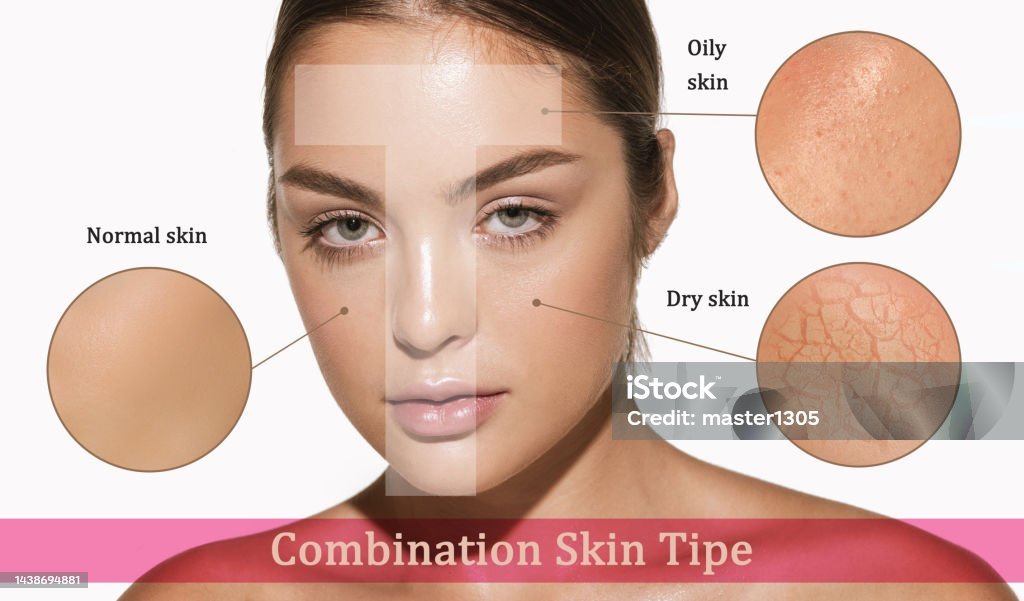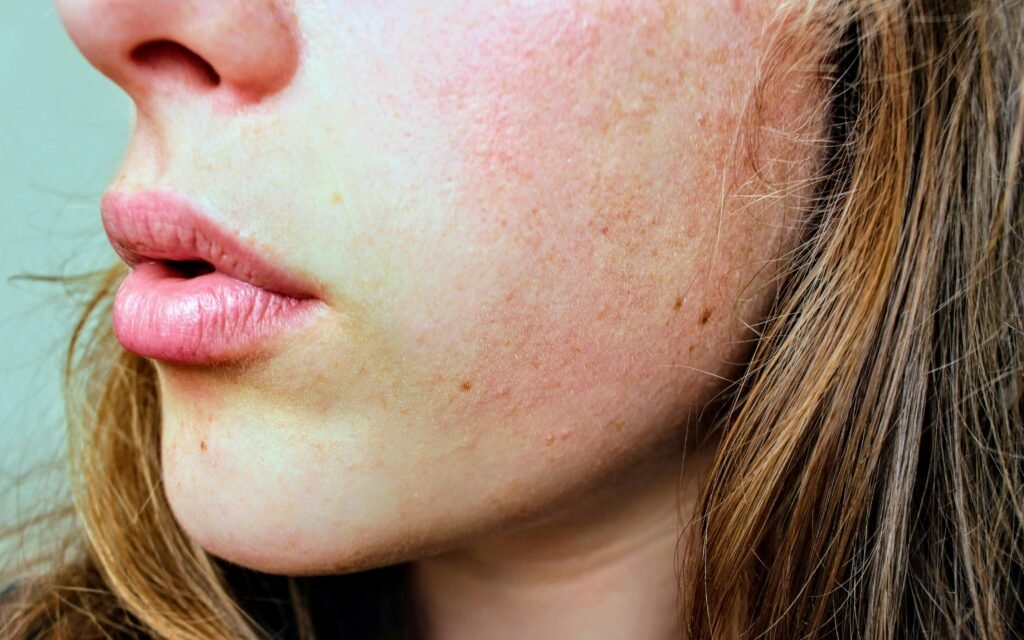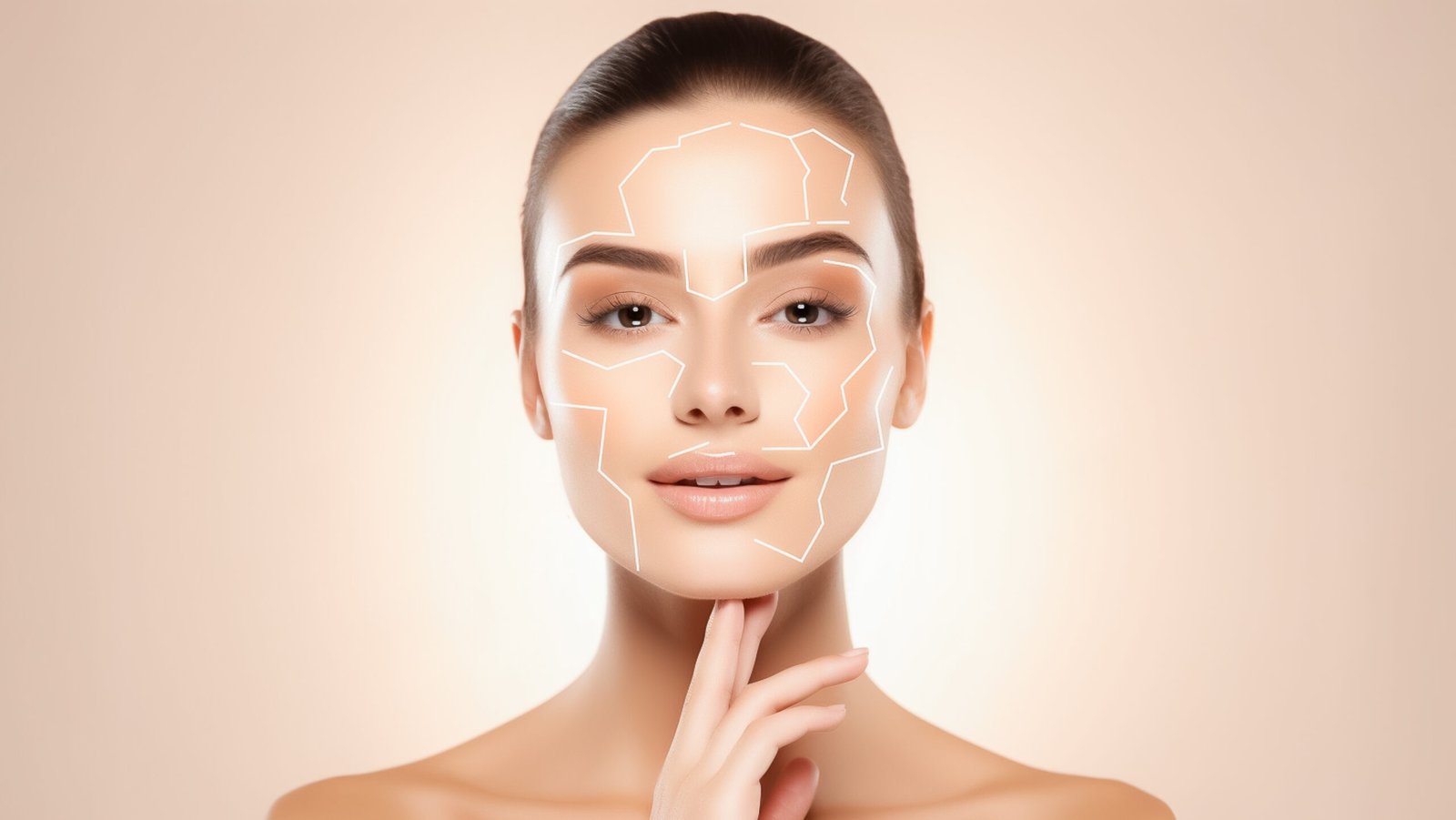It is extremely important to know your skin type which will help you take the first step in building a perfect skincare regime. Getting to know your skin—whether it be normal type, oily, dry or combination—or if you are sensitive and acne-prone will help keep it healthy. This deep dive into the Determining Your Skin Type will teach you a lot and some practical ways for its care also.
Six Basic Skin Types: An Overview

Understanding the six basic skin types will help you better manage your skincare routine. So, instead of planning to visit the dermatologist once quarantines lift—below is a short digest on everything you need to know about how to find out your skin type.
Type 0: Normal SkinNormal skin is not too oily or dry, and it feels healthy and clean yet never patchy.
Normal skin: Lab coat with a tendency to produce excess oils that makes you look greasy and then like pizza face.
Dry Skin: Dry skin does not have enough moisture, which can make your skin feel tight and cause flakiness or a rough texture.
Combination Sheet: Oily T region (forehead, nose and chin)Drier the rest Face without a doubt MeduParamedics Skin.
Sensitive Skin: Irritable, redness-prone and reactive to anything that may set it off.
Acne: Breakout-prone that includes pustules, blackheads and cysts
Now as we are clear with the basic, let’s know a little in depth about each skin type and how to take care of them.
See also: Men’s Skincare Routine: Simple and Effective Skincare Tips
1. Determining Normal Skin: Understanding the Ideal Skin Type

Normal Skin: Normal skin is considered the perfect type of skin since it has a healthy amount of sebum as well. This is why you will discover that by knowing your own skin, it keeps producing the right amount of natural oil to regulate and hydrate resulting in a not too oily… but never dry face! It has smooth texture, healthy glow, less sensitive skin which is easy to maintain.
1. What are the Characteristics of Normal Skin?
- Texture: When determining your skin type, you’ll find that normal skin boasts a smooth and even texture. It feels soft and supple to the touch without any rough patches or dryness. This skin type doesn’t exhibit signs of oiliness or tightness, making it comfortable and well-hydrated.
- Appearance: For those with normal skin, it typically results in a naturally radiant and healthy appearance. The skin exhibits a balanced glow that is neither too shiny nor too dull. It has an even tone with no visible redness or discoloration, contributing to a vibrant and fresh look.
- Pores: Normal skin usually features small, barely noticeable pores. They are evenly distributed and do not appear enlarged or clogged. This contributes to a smooth and clear complexion, free from blackheads or excess oil buildup.
- Sensitivity: In terms of sensitivity, normal skin is generally resistant to irritation. It rarely experiences redness, itching, or discomfort, making it less susceptible to allergic reactions or adverse effects from new products. This stability is a hallmark of healthy skin.
Skincare Tips for Normal Skin
- Cleansing: Use a gentle cleanser that hydrates your skin; it is important to balance the oils in our face as an acidic layer protect us from damage caused by external agents. Stick with cleansers containing gentle, non-stripping ingredients to rid the skin of damaging agents but sustain its natural oils. This helps the skin keep its natural moisture balance.
- Hydrate: Apply a non pore clogging lightweight moisturizer to normal skin ensures balance and hydration. Opt for products which hydrate without being too rich and greasy Hydrating Moisturizers: Hyaluronic acid, glycerin-based moisturizer will do the magic and keep your skin hydrated all day long.
- Sun Protection: Even if your skin is normal, you still need daily sun protection. Always use a sunscreen with at least SPF 30 to protect against UVA and UVB. Pick sunscreens that are made for daily use and non-comedogenic to reduce pore blockages.
Benefits of Normal Skin
- Ease of Maintenance: Compared to other skin types, normal type is easy going. Being very stable, it takes well to most skin care products and regimens so keeping the complexion in a good shape is uncomplicated accordingly.
- Versatility: Individuals with normal skin can experiment with a wide range of skincare products without significant adverse reactions. This flexibility allows for adjustments based on changing needs or preferences without risking skin issues.
- Less Prone to Issues: Normal skin is less likely to encounter common skin problems such as acne, excessive dryness, or irritation. Its balanced nature helps prevent breakouts and other skin conditions, contributing to a clear and healthy appearance.
- Adaptability: Normal skin adapts well to seasonal changes and variations in climate. Whether in hot and humid conditions or cold and dry environments, normal skin remains stable and resilient, reducing the need for drastic changes in skincare routines.
Maintaining Normal Skin
After your normal skin, further dedication to soft skincareProvide diet and moisturizing products for cleaning up the regimen.
2. Oily Skin: Managing Shine and Acne

Overproduction of sebum is the cause behind oily skin, resulting in its shiny appearance and most likely acne breakouts as well as other skin woes. This skin type is often oily, and the face frequently looks shiny especially at the T-zone (forehead,nose, chin. Good management is the key to calm skin and good pose with oily cheeks.
Characteristics of Oily Skin
- Texture: The oily skin often has the greasy and an unsmooth texture. It also produces sebum which can leave your skin feeling greasy to the touch and looking slippery. The texture can be due to clogged pores which also contribute to the bumpy appearance.
- Appearance: Individuals with oily skin often experience noticeable shine, especially in the T-zone. This shine can be more pronounced throughout the day as the skin continues to produce sebum. The appearance of excess oil can lead to a less matte and more reflective surface.
- Pores: Enlarged and more visible pores are a common characteristic of oily skin. The excess oil can stretch and clog pores, making them more prominent. This can lead to blackheads, whiteheads, and other forms of acne.
- Sensitivity: Because the oil on an oily skin type can trap dead skin cells and bacteria much more easily, it in turn means they are much easier to agitate. This influx of oil production can make your skin nightmare breeding ground and cause you to have acne breakouts more frequently or even worse.volley them.
Skincare Tips for Managing Oily Skin
- Cleansing: a gel or foamy soap to better clean the amount of fat. The light foaming action helps to remove superficial oil and leave the skin clean, but not stripped. Seek some products that contain salicylic acid, or benzyl peroxide to treat acne and help prevent it from coming back.
- Moisturizing: choose oil-free, non-comedogenic moisturizer which not curse clogging up the pores causing greasiness. Using gel or water-based moisturizers is also the best option for keeping your skin fresh without adding extra grease. For example, with ingredients like hyaluronic acid, can not only keep your skin hydrated but also make it look matte.
- Sun Protection: Wear a mattifying non-greasy sun screen as it not only help prevent over shining but also save your skin from harmful uva and uvb rays. It also has the benefit of making your skin look less oily and disgusting thanks to its matte finish or oil-erasing properties, which is definitely a good thing. Look for sunscreens with non-comedogenic on the label to prevent pore blockage.
Benefits of Properly Managing Oily Skin
- Reduced Shine: When you know your skin type and have an effective skincare regimen, shine is less likely to appear out of control leading to a matte-er(face sry.) complexion. The right products will help limit oil production and make the greasy look fade throughout the day also.
- Fewer Breakouts: When you accurately determine your skin type and control excess oil, you can experience fewer breakouts and acne-related issues. Proper cleansing and moisturizing prevent pore clogging, thereby minimizing acne formation.
- Improved Texture: Determining your skin type accurately and consistently using appropriate skincare products can improve the texture of oily skin. Regular cleansing and exfoliation help smooth out rough patches and reduce the bumpy texture associated with clogged pores.
- Balanced Skin: A healthier oily skin routine can result in balanced looking complexion. This balances out excess oil controlling, and a better yield in the skin health leads to a fresher more even complexion.
Maintaining Oily Skin
Skincare routine for oily skin: Oily skincare must tend to open pores, oil control and acne-proofing. Opt for foaming cleansers, oil-free moisturisers and mattifying sunscreens in your daily skin regimen. When followed these tips, it can help you control shine and breakouts to get that clearer looking complexion of yours.
3. Dry Skin: Embracing Hydration

Dry skin is characterized by a lack of sufficient moisture, leading to a feeling of tightness, roughness, or flakiness. This skin type can be prone to a variety of issues, including irritation, redness, and an overall dull appearance. Proper hydration is essential for maintaining the skin’s health and improving its texture and appearance.
Characteristics of Dry Skin
- Texture: Dry skin often appears rough, scaly, or dull. The lack of moisture can lead to a rough texture, where the skin may feel uneven or flaky. This rough texture is a result of the skin’s inability to retain adequate hydration.
- Appearance: Dry skin may show visible signs of flakiness or redness. The skin’s surface can become dry and patchy, leading to a less smooth and even complexion. Redness and irritation are common due to the skin’s lack of moisture and natural oils.
- Pores: The pores on dry skin are generally small and less noticeable. Since the skin is not producing excess oil, the pores do not become enlarged or clogged. However, the small pores can still be prone to becoming clogged if the skin is not properly exfoliated.
- Sensitivity: Dry skin is more susceptible to irritation and redness. The lack of moisture can weaken the skin’s barrier, making it more sensitive to environmental factors and skincare products. This sensitivity can lead to discomfort and a heightened reaction to new products.
Skincare Tips for Dry Skin
- Cleansing: Use a gentle, hydrating cleanser that helps retain moisture while cleansing the skin. Avoid cleansers with harsh or stripping ingredients that can further dry out the skin. Opt for cream-based or micellar cleansers that provide a soothing effect and prevent moisture loss.
- Moisturizing: Apply a rich, emollient moisturizer to hydrate and repair the skin’s barrier. Look for products with ingredients such as ceramides, hyaluronic acid, and glycerin to provide deep hydration and lock in moisture. Heavy creams or ointments are ideal for preventing dryness and maintaining skin softness.
- Sun Protection: Choose a hydrating sunscreen with added moisturizers to protect against UV damage while keeping the skin hydrated. Sunscreens with added emollients or oils can provide extra moisture and prevent the skin from becoming dry and flaky.
Benefits of Properly Managing Dry Skin
- Increased Hydration: Consequently, effective skincare routines for dry skin lead to improved hydration levels, resulting in a more supple and comfortable complexion. Regular use of hydrating products helps to restore moisture and maintain skin softness.
- Smoother Texture: Additionally, proper hydration and moisturizing can improve the texture of dry skin. By addressing dryness and flakiness, the skin becomes smoother and more even, reducing rough patches and enhancing overall appearance.
- Reduced Irritation: Furthermore, consistent moisturizing and gentle cleansing help to soothe and reduce irritation associated with dry skin. By maintaining the skin’s moisture barrier, you can minimize redness and discomfort, leading to a more balanced and comfortable complexion.
- Healthier Appearance: Well-hydrated skin appears healthier and more radiant. Addressing dryness and maintaining proper moisture levels contribute to a vibrant and refreshed look, enhancing your skin’s natural glow and overall health.
Maintaining Dry Skin
To effectively manage dry skin, determine your skin type and follow a skincare routine that emphasizes hydration, gentle cleansing, and sun protection. Incorporate rich moisturizers, hydrating cleansers, and sunscreens with added moisture into your daily regimen. By maintaining these practices, you can keep your skin hydrated, smooth, and healthy.
4. Combination Skin: Balancing Different Areas
Combination skin is characterized by having both oily and dry areas on the face. Typically, the T-zone (forehead, nose, chin) is oilier, while the cheeks and other areas may be drier. Managing combination skin involves addressing the unique needs of each area to achieve a balanced and harmonious complexion.
Characteristics of Combination Skin
- Texture: Combination skin has a varied texture across different areas. The T-zone may feel oily and shiny, while the cheeks and other areas may feel dry or normal. This variation can result in an uneven texture across the face.
- Appearance: Combination skin presents with a mix of different appearances. The T-zone may appear greasy and prone to shine, while the drier areas can look dull or flaky. This uneven appearance requires a tailored skincare approach to address both concerns.
- Pores: Pores in the oily areas of combination skin, such as the T-zone, may appear enlarged and prone to clogging. In contrast, the pores in drier areas are typically smaller and less noticeable. Proper care involves managing pore size and preventing congestion in oily zones while maintaining hydration in drier areas.
- Sensitivity: Combination skin can experience varying levels of sensitivity depending on the area. The oily parts may be prone to acne and irritation, while the drier areas may be sensitive and prone to redness or flakiness. A balanced approach is needed to address both types of sensitivity.
Skincare Tips for Managing Combination Skin
- Cleansing: Use a gentle cleanser that effectively removes excess oil from the T-zone while maintaining hydration in drier areas. Consider using a mild foaming cleanser or a balancing gel that addresses both oily and dry zones without causing imbalance.
- Moisturizing: Apply a lightweight, oil-free moisturizer to balance hydration across all areas of the face. Gel-based or combination moisturizers are ideal for providing adequate moisture without exacerbating oiliness or dryness.
- Sun Protection: Choose a broad-spectrum sunscreen that offers balanced protection without adding extra oil or dryness. Look for formulations that cater to combination skin and provide a matte finish in the T-zone while hydrating the drier areas.
Benefits of Properly Managing Combination Skin
- Balanced Complexion: Effective skincare for combination skin helps achieve a harmonious and balanced complexion. By addressing both oily and dry areas, you can minimize shine, reduce flakiness, and create a more even and unified appearance.
- Controlled Oil Production: Proper management of combination skin helps control excess oil in the T-zone while preventing dryness in other areas. This balance reduces the likelihood of breakouts and ensures a more comfortable and manageable complexion.
- Improved Hydration: Targeted moisturization for combination skin enhances hydration in drier areas while avoiding excessive oiliness. This helps to maintain a healthy moisture balance and improves overall skin texture and appearance.
- Reduced Sensitivity: A well-managed skincare routine for combination skin helps to address varying sensitivities across different areas. By using suitable products for each zone, you can reduce irritation and achieve a more comfortable and resilient complexion.
Maintaining Combination Skin
To effectively manage combination skin, adopt a skincare routine that addresses both oily and dry areas. Incorporate gentle cleansers, lightweight moisturizers, and balanced sunscreens into your daily regimen. By following these practices, you can achieve a well-balanced, clear, and healthy complexion.
5. Sensitive Skin: Gentle Care for Delicate Complexions
Sensitive skin is easily irritated and prone to redness, itching, or discomfort. This skin type reacts strongly to various products or environmental factors, making it crucial to choose skincare products that are gentle and non-irritating. Proper care is essential to maintaining a calm and healthy complexion for sensitive skin.
Characteristics of Sensitive Skin
- Texture: Sensitive skin often feels delicate and may show signs of redness or irritation. Consequently, the texture can be uneven, with areas of dryness or roughness. Sensitivity can lead to heightened reactions to external factors or products.
- Appearance: Individuals with sensitive skin may experience visible redness, flushing, or broken capillaries. Additionally, the skin can appear inflamed or reactive, and may be prone to developing rashes or hives in response to triggers.
- Pores: Pores on sensitive skin are typically normal or smaller in size. However, the skin’s sensitivity can lead to irritation around the pores, causing them to appear more pronounced or red.
- Sensitivity: Sensitivity is the primary characteristic of this skin type. Sensitive skin reacts easily to changes in products, weather conditions, or other environmental factors. It may also be prone to allergic reactions or adverse effects from skincare ingredients.
Skincare Tips for Sensitive Skin
- Cleansing: Use a mild, fragrance-free cleanser that is gentle on the skin. Avoid products with harsh ingredients, alcohol, or strong fragrances, as these can exacerbate sensitivity. Opt for soothing cleansers with calming ingredients like chamomile or aloe vera.
- Moisturizing: Apply a hypoallergenic, non-comedogenic moisturizer to soothe and protect the skin. Choose products with minimal ingredients and avoid potential irritants. Look for moisturizers with soothing agents such as ceramides or colloidal oatmeal.
- Sun Protection: Use a gentle, mineral-based sunscreen with physical blockers like zinc oxide or titanium dioxide. These sunscreens are less likely to irritate sensitive skin and provide effective protection from UV damage. Avoid sunscreens with added fragrances or chemicals that can trigger sensitivity.
Benefits of Properly Managing Sensitive Skin
- Reduced Irritation: By using gentle, non-irritating products, you can minimize redness and discomfort associated with sensitive skin. Thus, determining your skin type is crucial to soothe the skin and reduce the likelihood of adverse reactions.
- Calmer Complexion: Effective skincare routines for sensitive skin lead to a more balanced and calm complexion. Therefore, by addressing triggers and using soothing products, you can achieve a more even and less reactive appearance.
- Improved Comfort: Properly managing sensitive skin enhances overall comfort and reduces feelings of tightness or discomfort. As a result, by choosing suitable products and maintaining a consistent routine, you can alleviate sensitivity and enjoy a more comfortable skin experience.
- Healthier Skin Barrier: Gentle care helps to strengthen and protect the skin barrier, improving its resilience against irritants and environmental stressors. Consequently, a well-maintained barrier contributes to healthier, more resilient skin.
Maintaining Sensitive Skin
To effectively manage sensitive skin, adopt a skincare routine that emphasizes gentleness, hydration, and sun protection. Incorporate mild cleansers, soothing moisturizers, and gentle sunscreens into your daily regimen. By following these practices, you can maintain a calm, healthy, and balanced complexion.
6. Acne-Prone Skin: Managing Breakouts and Oiliness
Acne-prone skin is characterized by frequent breakouts, including pimples, blackheads, and cysts. This skin type is often marked by excess oil production, clogged pores, and inflammation. Effective management, including determining your skin type, is essential to control breakouts and maintain clear skin.
Characteristics of Acne-Prone Skin
- Texture: Acne-prone skin can have a bumpy texture due to the presence of pimples, blackheads, and clogged pores. The skin may feel uneven and rough in areas affected by breakouts or acne lesions.
- Appearance: Acne-prone skin often exhibits visible breakouts, including red, inflamed pimples and blackheads. The skin may appear oily and shiny, particularly in the T-zone, with noticeable blemishes and uneven skin tone.
- Pores: Enlarged and clogged pores are common in acne-prone skin. The excess oil and dead skin cells can lead to pore congestion and the formation of acne lesions. Proper care involves managing pore size and preventing clogging.
- Sensitivity: Acne-prone skin can be sensitive and reactive, especially when using harsh acne treatments or products. It is important to choose products that are effective yet gentle to avoid exacerbating irritation.
Skincare Tips for Acne-Prone Skin
- Cleansing: Use a gentle, non-comedogenic cleanser to remove excess oil and impurities without clogging pores. For best results, opt for products with salicylic acid or benzoyl peroxide to target acne-causing bacteria and prevent breakouts.
- Moisturizing: Additionally, apply a lightweight, oil-free moisturizer to maintain hydration without adding extra oil. Gel-based or non-comedogenic moisturizers are ideal for acne-prone skin; avoid heavy creams that can clog pores.
- Sun Protection: Choose a broad-spectrum sunscreen that is oil-free and non-comedogenic. Sunscreens with added ingredients like niacinamide can help to soothe and reduce inflammation associated with acne-prone skin.
Benefits of Properly Managing Acne-Prone Skin
- Fewer Breakouts: Effective skincare routines for acne-prone skin help to reduce the frequency and severity of breakouts. By determining your skin type and using targeted treatments, you can minimize the occurrence of pimples and blackheads.
- Controlled Oil Production: Proper management of acne-prone skin helps to balance oil production, reducing excess shine and preventing clogged pores. Consequently, this balance contributes to a clearer and more even complexion.
- Improved Skin Texture: Regular use of suitable products can enhance the texture of acne-prone skin by addressing roughness and unevenness caused by breakouts. As a result, smoother skin emerges from effective exfoliation and hydration.
- Reduced Inflammation: Gentle, targeted treatments help to soothe and reduce inflammation associated with acne-prone skin. Thus, this results in a calmer and less irritated complexion.
Maintaining Acne-Prone Skin
To effectively manage acne-prone skin, follow a skincare routine that includes gentle cleansing, targeted treatments, and oil-free moisturizing. Additionally, by determining your skin type, you can incorporate suitable products and sun protection into your daily regimen, leading to clearer, balanced, and healthy skin.
Conclusion:
So, when it comes to a perfect skincare routine everything starts with understanding/identifying your type of skin. It can direct you to select the correct products and methods, made according to the status of your skin that enables it healthier radiant way. It is necessary to know your skin type as it helps you take proper actions that lead towards good results on the ground.
See also: Men’s Skincare Routine: Simple and Effective Skincare Tips
Disclaimer:
The information outlined in the article is for educational purposes only and should not be used as medical advice. As always, you should use any new products or make diet changes based on the recommendation of a board-certified dermatologist or healthcare professional. Or even better, individual skin tee types are sensitive and they may react differently than standard expectations.
Refferance:
Dermatology Organizations: Provide authoritative advice and research on skin care and skin types.
Skincare Research and Reviews: Offer insights and reviews on products and practices for various skin types.
- PubMed (for accessing dermatological studies)
- SkinCeuticals Blog
Trusted Beauty Websites: Provide product recommendations and expert advice on skin care.
Educational Health Websites: Include general skincare advice and health information.


Can you be more specific about the content of your article? After reading it, I still have some doubts. Hope you can help me.
Hi! dear. Please let me know how can i help you?
I don’t think the title of your article matches the content lol. Just kidding, mainly because I had some doubts after reading the article.